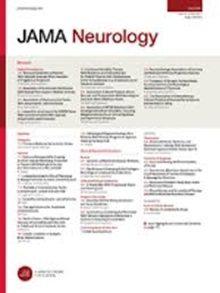环境空气污染与阿尔茨海默病的严重程度神经病理学。
IF 21.3
1区 医学
Q1 CLINICAL NEUROLOGY
引用次数: 0
摘要
暴露于细颗粒物空气污染(PM2.5)可能会增加患痴呆症的风险。目前尚不清楚这种关联是否由尸检中发现的与痴呆相关的神经病理改变介导。目的探讨PM2.5暴露、痴呆严重程度和痴呆相关神经病理改变之间的关系。设计、环境和参与者本队列研究使用了宾夕法尼亚大学神经退行性疾病研究中心脑库1999年至2022年收集的尸检病例相关数据。数据分析时间为2025年1月至6月。参与者包括602例常见形式的痴呆和/或运动障碍患者,以及排除了429例缺乏神经病理测量、人口统计学因素、APOE基因型或居住地址数据的老年对照。使用居住地址的时空预测模型估计死亡前或最后一次临床痴呆评级盒之和(CDR-SB)评估前的一年平均PM2.5浓度。主要结局和测量方法痴呆严重程度通过CDR-SB评分来衡量。10项与痴呆相关的神经病理学指标,包括阿尔茨海默病、路易体病、边缘显性年龄相关交互反应dna结合蛋白(TDP)-43脑病和脑血管病,被分级或分期。采用线性、逻辑和结构方程模型来检验PM2.5、CDR-SB和神经病理学指标之间的关系,并对人口统计学因素和APOE ε4等位基因状态进行了调整。结果在602例尸检病例中(死亡年龄中位数为78[71-85]岁;男性328例[54.5%],女性274例[45.5%]),死亡前较高的PM2.5暴露与更严重的阿尔茨海默病神经病理改变(ADNC)的几率增加相关(优势比为1.19;95% CI为1.11-1.28)。在287例有CDR-SB记录的病例中(死亡年龄中位数为79[72-86]岁;男性154[53.7%],女性133[46.3%]),在CDR-SB评估前较高的PM2.5暴露与更严重的认知和功能障碍相关(β = 0.48; 95% CI, 0.22-0.74)。最后,高PM2.5暴露与更严重的认知和功能障碍之间63%的关联在统计学上由ADNC介导(β = 0.30; 95% CI, 0.04-0.53)。在这项研究中,PM2.5暴露与痴呆严重程度增加和ADNC增加有关。需要以人群为基础的研究来更好地理解这种关系。本文章由计算机程序翻译,如有差异,请以英文原文为准。
Ambient Air Pollution and the Severity of Alzheimer Disease Neuropathology.
Importance
Exposure to fine particulate matter air pollution (PM2.5) may increase risk for dementia. It is unknown whether this association is mediated by dementia-related neuropathologic change found at autopsy.
Objective
To examine associations between PM2.5 exposure, dementia severity, and dementia-associated neuropathologic change.
Design, Setting, and Participants
This cohort study used data associated with autopsy cases collected from 1999 to 2022 at the Center for Neurodegenerative Disease Research Brain Bank at the University of Pennsylvania. Data were analyzed from January to June 2025. Participants included 602 cases with common forms of dementia and/or movement disorders and older controls after excluding 429 cases with missing data on neuropathologic measures, demographic factors, APOE genotype, or residential address.
Exposures
One-year mean PM2.5 concentration prior to death or prior to last Clinical Dementia Rating Sum of Boxes (CDR-SB) assessment was estimated using a spatiotemporal prediction model at residential addresses.
Main Outcomes and Measures
Dementia severity was measured by CDR-SB scores. Ten dementia-associated neuropathologic measures representing Alzheimer disease, Lewy body disease, limbic-predominant age-related transactive response DNA-binding protein (TDP)-43 encephalopathy, and cerebrovascular disease were graded or staged. Linear, logistic, and structural equation models were used to examine the associations between PM2.5, CDR-SB, and neuropathologic measures, adjusting for demographic factors and APOE ε4 allele status.
Results
In a total of 602 autopsy cases (median [IQR] age at death, 78 [71-85] years; 328 male [54.5%] and 274 female [45.5%]), higher PM2.5 exposure prior to death was associated with increased odds of more severe Alzheimer disease neuropathologic change (ADNC) (odds ratio, 1.19; 95% CI, 1.11-1.28). In a subset of 287 cases with CDR-SB records (median [IQR] age at death, 79 [72-86] years; 154 [53.7%] male and 133 female [46.3%]), higher PM2.5 exposure prior to CDR-SB assessment was associated with greater cognitive and functional impairment (β = 0.48; 95% CI, 0.22-0.74). Lastly, 63% of the association between higher PM2.5 exposure and greater cognitive and functional impairment was statistically mediated by ADNC (β = 0.30; 95% CI, 0.04-0.53).
Conclusions and Relevance
In this study, PM2.5 exposure was associated with increased dementia severity and increased ADNC. Population-based studies are needed to better understand this relationship.
求助全文
通过发布文献求助,成功后即可免费获取论文全文。
去求助
来源期刊

JAMA neurology
CLINICAL NEUROLOGY-
CiteScore
41.90
自引率
1.70%
发文量
250
期刊介绍:
JAMA Neurology is an international peer-reviewed journal for physicians caring for people with neurologic disorders and those interested in the structure and function of the normal and diseased nervous system. The Archives of Neurology & Psychiatry began publication in 1919 and, in 1959, became 2 separate journals: Archives of Neurology and Archives of General Psychiatry. In 2013, their names changed to JAMA Neurology and JAMA Psychiatry, respectively. JAMA Neurology is a member of the JAMA Network, a consortium of peer-reviewed, general medical and specialty publications.
 求助内容:
求助内容: 应助结果提醒方式:
应助结果提醒方式:


